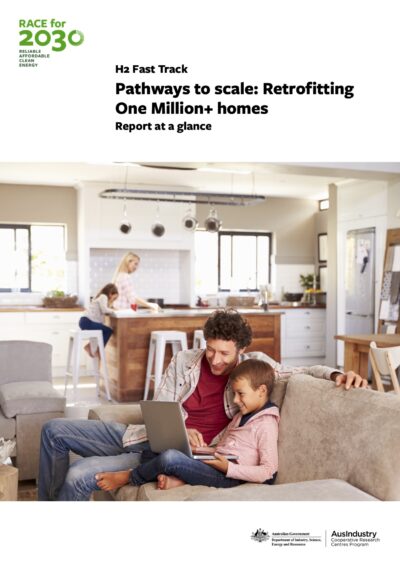13 December 2021, Perth – Promising findings from the latest report out of the Reliable Affordable Clean Energy for 2030 Cooperative Research Centre (RACE for 2030 CRC), validates the growing interest in the need for Australian home retrofits for thermal and energy efficiency. The report, entitled Pathways to Scale: Retrofitting One Million+ Homes, outlines the design and implementation of a home retrofit scheme in Australia, and outlines need for further research.
Australia needs a targeted and coordinated effort to retrofit the millions of existing homes. The report presents the foundational research that will underpin an effort to engage private finance to begin by retrofitting over one million Australian homes for thermal and energy efficiency. The proposed scheme aims to retrofit homes so that they can support Australia’s current and future comfort and energy needs and facilitate the transition to renewable energy.
Maximising thermal and energy efficiency in homes, moving energy demand into periods of maximum renewable generation, and enabling electrification can also support the transition toward net zero.
According to Project Lead, Principal Innovation Projects from Climate-KIC Australia, Karla Fox-Reynolds: “The way we generate and use energy is transforming. Our homes need to evolve alongside this to support our needs for comfort, efficiency, and resilience, as well as a net zero future. Our research indicates that for our homes to be equipped for the energy transition we need large-scale home retrofit scheme.” Mrs Fox-Reynolds noted how a successful scheme of this type will be based on an “ecosystem that includes opportunities for collaboration and partnership between homeowners, tenants, investors, industry, and government.”
Although a retrofit can be as simple as installing roof insulation and draught proofing to improve the building envelope, it can extend to more advanced upgrades such as energy efficient appliances, rooftop solar coupled with the potential for battery storage and heat pumps water heaters. And this is where the economic benefits are found. The report’s modelling found that a combination of all the proposed upgrades could save nearly 100% of energy use and related emissions, whilst basic upgrades would deliver energy use savings of between 18 and 31%.
A bespoke home retrofit, addressing needs identified through a whole-of-home assessment could reduce an average home energy bill by up to $1,600 per year.
Based on modelling so far, a home retrofit scheme targeting improvement of one million existing Australian homes across five years could:
- Reduce home energy use by up to 9,000 kWh per year per home
- Reduce home emissions by up to 5.8 tonnes of CO2 eq per year per home
- Create an up to $55 billion of private finance investment opportunity
The research highlights a need for a home retrofit scheme that would provide independent technical guidance for homeowners, enables industry accreditation, whilst supporting the intentions of the Trajectory for Low Energy Buildings and net zero emission targets.
The report examined numerous studies which also showed significant health and well-being improvements have come from successful international retrofit schemes. The health benefits identified are particularly significant for vulnerable groups such as children and the elderly. Further research is being proposed to quantify the true health impact of home retrofits in Australia. The report proposes an Australian scheme that targets the creation of ‘future ready homes’ meaning existing homes that are comfortable as well as thermally and energy efficient with a path toward full electrification.
The scheme would create new jobs, especially in home assessment and housing and construction services whilst stimulating private finance and investment in the Australian home retrofit market. “Given the poor energy efficiency and thermal comfort of Australian homes, it is critical that we can retrofit homes at scale to decarbonise the economy. This report provides guidance on how that can be achieved”, said RACE for 2030 CEO, Jon Jutsen. The report proposal delivers an opportunity for collaboration and partnership between homeowners, tenants, investors, industry, and government to develop, enable and implement the market demand and the ecosystem required to retrofit Australian homes and contribute to meeting our net zero emissions targets.
This fast-track project was led by Climate-KIC Australia and supported by the NSW Department of Planning, Industry and Environment, Victorian Department of Environment, Land, Water and Planning, Curtin University, University of Technology Sydney and eleXsys.
– ENDS–
For more information, please contact: Karla Fox-Reynolds | karla.fox-reynolds@climate-kic.org.au | 0426 230 651
“The way we generate and use energy is transforming. Our homes need to evolve alongside this to support our needs for comfort, efficiency, and resilience, as well as a net zero future. Our research indicates that for our homes to be equipped for the energy transition we need large-scale home retrofit scheme.”
Karla Fox-Reynolds, Principal – Innovation Projects, Climate-KIC Australia



